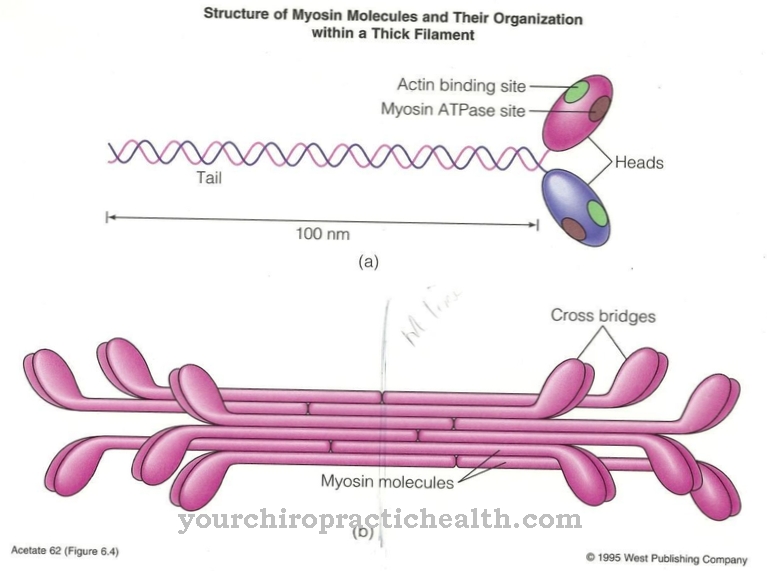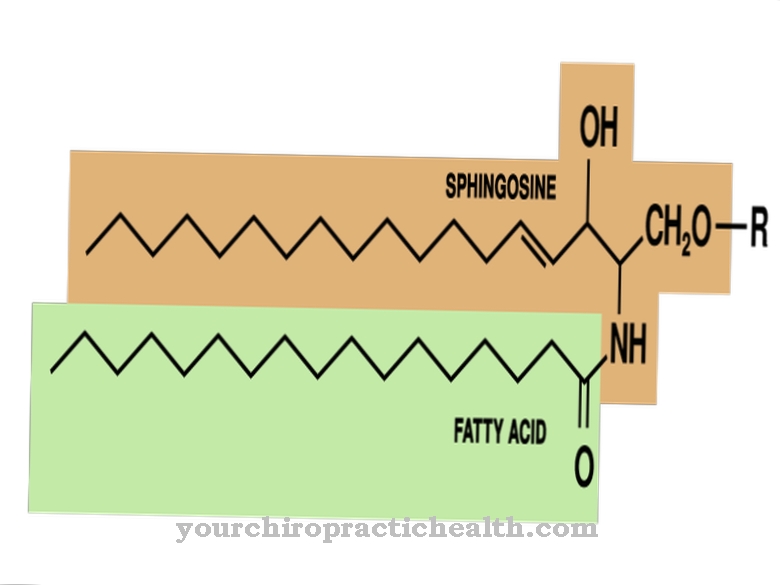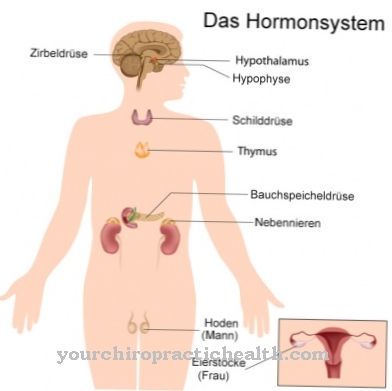The Tetrahydrofolic acid As coenzyme F, it plays an important role in the transfer of carbon in the organism. It is synthesized from folic acid (vitamin B9). A lack of THF triggers, among other things, pernicious anemia.
What is Tetrahydrofolic Acid?
Tetrahydrofolic acid acts as an important carbon donor. In many biochemical processes it transfers carbon-containing groups such as the methyl, methylene, formyl, forminmino or methenyl group. Tetrahydrofolic acid is always bound to polyglutamic acid in the metabolism.
The compound is synthesized from folic acid in two steps. With the help of the enzyme dihydrofolate reductase, dihydrofolic acid is initially produced, which is reduced to tetrahydrofolic acid with the addition of additional hydrogen atoms. The starting material folic acid is also known as vitamin B9 or vitamin B11. Folic acid is made up of paraaminobenzoic acid, L-glutamic acid and a pteridine derivative. Pteridine consists of a dinuclear aromatic hetero ring.
In order to produce THF, the hydrogenations take place on this pteridine ring, so that the aromatic character of this binuclear ring is canceled. Tetrahydrofolic acid acts in the cytosol and in the mitochondria. Because it is bound to polyglutamic acid, it is no longer possible to leave the cell. This is how THF can develop its full effect here.
Function, effect & tasks
The main role of tetrahydrofolic acid is to transfer carbon. To this end, various carbon-containing atom groups can be transported. The transfer of the methyl group to other molecules is of great importance.
The methylated form of THF, N5-methyl-THF, acts as a methyl group donor. With the help of N5-methyl-THF and cobalamin (vitamin B12), homocysteine is methylated to methionine, which is still available as a starting compound for the methyl group carrier S-adenosylmethionine (SAM). THF also plays a major role in the synthesis of nitrogen bases such as thymine, adenine or guanine. Tetrahydrofolic acid thus also has a great indirect influence on nucleic acid synthesis. Furthermore, THF is also of great importance in homoacetate fermentation and the detoxification of formic acid. Homoacetate fermentation is the anaerobic bacterial conversion of sugars into acetic acid.
THF also supports the conversion of glycine to serine. THF is always bound to polyglutamic acid as FH4 polyglutamate during the catalysis of these reactions. After the reactions, FH4 polyglutamate is unchanged and can be used again. THF is of such immense importance for the undisturbed flow of many biochemical processes that a deficiency in this coenzyme would result in serious health problems.
Education, occurrence, properties & optimal values
Tetrahydrofolic acid is produced in the body from folic acid with the help of dihydrofolate reductase. Folic acid (vitamin B9 or vitamin B11) is hydrogenated with four hydrogen atoms. However, folic acid is not synthesized in the body. It must always be taken with food. A folic acid deficiency would therefore also result in a THF deficiency. A daily dose of 400 micrograms folic acid is recommended.
With an intake of over 1000 micrograms per day, excess folic acid is excreted and therefore has no additional health effect. Below this amount, it is stored in the body in the form of FH2 and FH4 polyglutamate. Due to the size of the molecule, folic acid cannot leave the cells in this form. There is a particularly high amount of folic acid in yeast, legumes, grain germs and sunflower seeds. Veal and poultry liver also contain large amounts of folic acid.
In the body, folic acid is absorbed through the intestinal mucosa and taken up by the cells using transport proteins. There it is stored in DHF and THF immediately after hydrogenation by binding to polyglutamate. If there is an excess of folic acid, the synthesis of folate-transporting proteins decreases, so that the further uptake of folate into the cells is stopped.
Diseases & Disorders
If there is a deficiency in tetrahydrofolic acid, the main symptom is hyperchromic macrocytic anemia. Hyperchromic macrocytic anemia is also known as pernicious anemia.A distinction must first be made between a primary or a secondary deficiency in THF.
Anemia occurs in both cases. However, there are different causes. Primary THF deficiency cannot be viewed separately from folic acid deficiency. When the body receives or absorbs too little folic acid, there is also a shortage of THF. The secondary THF deficiency is caused by a deficiency in vitamin B12 (cobalamine). As coenzyme B12, vitamin B12 is responsible for the methylation of homocysteine to methionine. N5-methyl-tetrahydrofolate (N5-methyl-THF) acts as a carrier for methyl groups. However, this reaction does not occur if vitamin B12 fails.
N5-methyl-THF can no longer convert back to THF, so that there is a secondary THF deficiency. Among other things, THF is of great importance in the synthesis of the nucleic bases adenine, guanine and thymine. In the absence of THF, these reactions are inhibited. Furthermore, the nucleic acid synthesis is also disturbed. Since a lot of cell divisions take place during blood formation and consequently there is also a high need for nucleic acids, anemia develops. The few blood cells are literally overfilled with hemoglobin, so that the erythrocytes are greatly enlarged. In both secondary and primary THF deficiency, the symptoms of anemia disappear after additional folic acid administration.
However, after this treatment, if there is a secondary THF deficiency, the deficiency in vitamin B12 and its neurological symptoms persist. In addition to anemia, a folic acid deficiency also leads to an increase in the homocysteine level in the body. This increases the risk of arteriosclerosis. If there is a folic acid deficiency during pregnancy, the most severe neural tube defects such as anencephaly or spina bifida can develop in the newborn.












.jpg)



.jpg)










.jpg)
